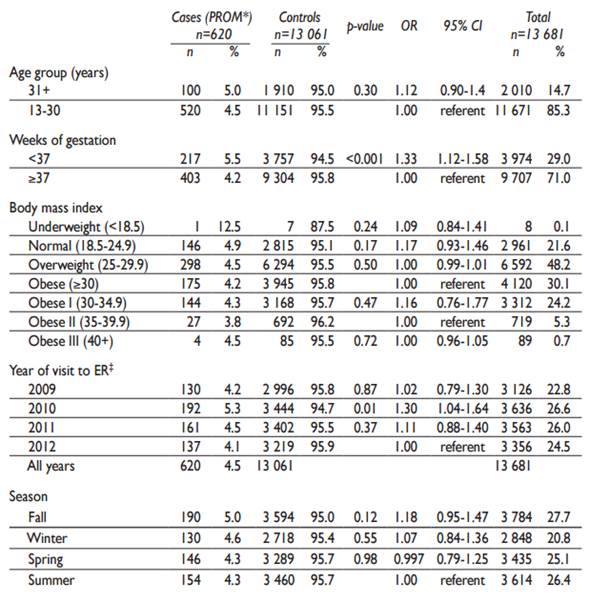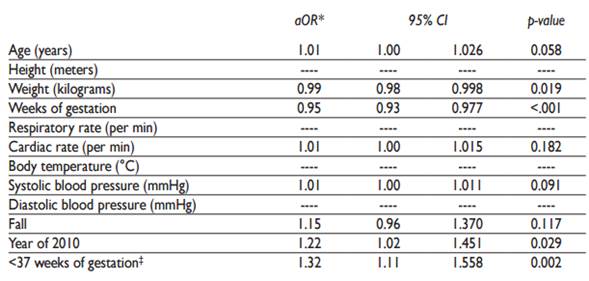Dear editor: The premature rupture of membranes (PROM) represents a health problem with an increased risk of infection and complications to mother and baby. PROM may result from various reasons including low socioeconomic status (SES), intraamniotic infection, second and third-trimester bleeding, nutritional disorders of copper and ascorbic acid, connective tissue disorders, cervical conisation or cerclage, pulmonary diseases, uterine overdistention, amniocentesis, previous preterm birth, short cervical length in the second trimester, women with preterm labor or symptomatic contractions in the current pregnancy.11. ACOG Committee on Practice Bulletins-Obstetrics. ACOG Practice Bulletin No. 80: premature rupture of membranes. Clinical management guidelines for obstetrician-gynecologists. Obstet Gynecol 2007;109:1007-1019. https://doi.org/10.1097/01.AOG.0000263888.69178.1f
https://doi.org/10.1097/01.AOG.000026388...
In this letter to the editor we show the results of a case-control study on the association between anthropometric characteristics and PROM in Mexican pregnant women attending the emergency room of Mónica Pretelini Hospital in Toluca, Estado de México between 2009 and 2012. A total of 13 681 women were seen with an overall PROM prevalence of 4.5% (620 cases with PROM, and 13 061 controls without PROM nor conditions associated with PROM). The preterm PROM (PPROM) prevalence was 5.5%. Cases and controls were similar with regard to mean age, height, respiratory rate, heart rate, body temperature and blood pressure (table I). PROM cases were 32% more likely to have a pregnancy of less than 37 weeks of gestation compared to controls. A 1-Kg lower maternal weight was associated with 1% increased risk of PROM in all women and for each gestational week less, the risk increased 5% (p<0.05, tables II and III).
A previous Mexican study from Sinaloa 22. Ortiz FM, Soto YG, del Refugio VG, Beltrán AG, Castro EQ, Ramírez IO. Factores sociodemográficos y obstétricos asociados con rotura prematura de membranas. Ginecol Obstet Mex 2008;76:468-475. Showed PPROM prevalence of 8.9% which is higher than our 5.5% estimate. The differences in estimates of prevalence might be partially explained by selection bias or sample size, for instance, the control group in our study was about ten times larger than the control group in the Sinaloa’s study. Our report is the first study showing the association between lower maternal weight during pregnancy and PROM in Mexican pregnant women. Previous studies showed that PPROM cases were more likely to have gained less than 21 pounds as compared to controls.33. Gosselink CA, Ekwo EE, Woolson RF, Moawad A, Long CR. Dietary habits, prepregnancy weight, and weight gain during pregnancy. Risk of pre term rupture of amniotic sac membranes. Acta Obstet Gynecol Scand 1992;71:425-438. https://doi.org/10.3109/00016349209021091
https://doi.org/10.3109/0001634920902109... These findings may indicate suboptimal nutritional status with deficiencies that put pregnant women at risk of PROM. For instance, low plasma levels of copper 44. Kiilholma P, Grönroos M, Erkkola R, Pakarinen P, Näntö V. The role of calcium, copper, iron and zinc in preterm delivery and premature rupture of fetal membranes. Gynecol Obstet Invest 1984;17:194-201. https://doi.org/10.1159/000299148
https://doi.org/10.1159/000299148... or vitamin C 55. Osaikhuwuomwan JA, Okpere EE, Okonkwo CA, Ande AB, Idogun ES. Plasma vitamin C levels and risk of preterm prelabour rupture of membranes. Arch Gynecol Obstet 2011;284:593-597. https://doi.org/10.1007/s00404-010-1741-5
https://doi.org/10.1007/s00404-010-1741-... have been associated with the presence of PROM. Vitamin C plays an important role in collagen metabolism and increases resistance maintenance of the chorioamniotic membranes. At the molecular level, PROM appears to result from diminished collagen synthesis, altered collagen structure, and accelerated collagen degradation, possibly in association with concurrent cellular changes within the fetal membranes.
In the present study, SES indicators were not available, which represent a potential confounder, however, a previous Mexican study22. Ortiz FM, Soto YG, del Refugio VG, Beltrán AG, Castro EQ, Ramírez IO. Factores sociodemográficos y obstétricos asociados con rotura prematura de membranas. Ginecol Obstet Mex 2008;76:468-475. showed no differences due to SES between PROM cases and controls. This may be explained by the type of population, in both Mexican studies pregnant women seeking attention usually come from the low SES because both hospitals are government hospitals under the Ministry of Health which serve the underserved. Future studies in Mexican women are needed to determine whether patients with PROM have specific deficiencies of vitamin C, copper or other nutritional disorders.
References
- 1ACOG Committee on Practice Bulletins-Obstetrics. ACOG Practice Bulletin No. 80: premature rupture of membranes. Clinical management guidelines for obstetrician-gynecologists. Obstet Gynecol 2007;109:1007-1019. https://doi.org/10.1097/01.AOG.0000263888.69178.1f
» https://doi.org/10.1097/01.AOG.0000263888.69178.1f - 2Ortiz FM, Soto YG, del Refugio VG, Beltrán AG, Castro EQ, Ramírez IO. Factores sociodemográficos y obstétricos asociados con rotura prematura de membranas. Ginecol Obstet Mex 2008;76:468-475.
- 3Gosselink CA, Ekwo EE, Woolson RF, Moawad A, Long CR. Dietary habits, prepregnancy weight, and weight gain during pregnancy. Risk of pre term rupture of amniotic sac membranes. Acta Obstet Gynecol Scand 1992;71:425-438. https://doi.org/10.3109/00016349209021091
» https://doi.org/10.3109/00016349209021091 - 4Kiilholma P, Grönroos M, Erkkola R, Pakarinen P, Näntö V. The role of calcium, copper, iron and zinc in preterm delivery and premature rupture of fetal membranes. Gynecol Obstet Invest 1984;17:194-201. https://doi.org/10.1159/000299148
» https://doi.org/10.1159/000299148 - 5Osaikhuwuomwan JA, Okpere EE, Okonkwo CA, Ande AB, Idogun ES. Plasma vitamin C levels and risk of preterm prelabour rupture of membranes. Arch Gynecol Obstet 2011;284:593-597. https://doi.org/10.1007/s00404-010-1741-5
» https://doi.org/10.1007/s00404-010-1741-5
Publication Dates
- Publication in this collection
Mar-Apr 2017




